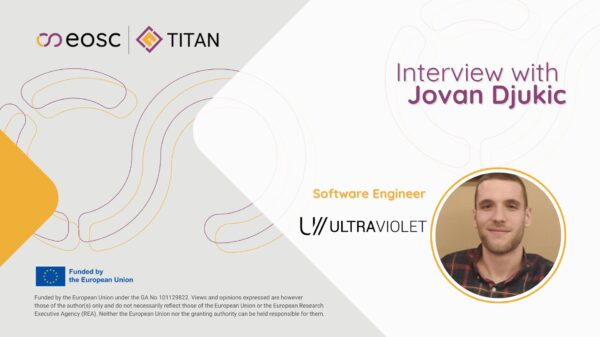Funded by the European Commission, TITAN (Trusted envIronments for confidenTiAl computiNg and secure data sharing) it’s a 36-month project that will deliver an open-source software platform focused on enabling secure sensitive data sharing, and demonstrate them in the EOSC ecosystem.
Ultraviolet, based in Belgrade, Serbia, specialises in cloud computing, AI/ML, and multi-party computation, with a strong focus on security and privacy. As an open-source contributor to industry standards and an active participant in EU research, Ultraviolet’s expertise in privacy-preserving technologies is vital to TITAN.
In this interview, Joan Djukic from Ultraviolet discusses the motivations behind their TITAN involvement, key considerations for designing a confidential data processing platform, and a visionary outlook on the project’s long-term impact on research and the EOSC ecosystem.

What motivated Ultraviolet to become a partner in the TITAN-EOSC project?
Ultraviolet is building open-source tools that make privacy-preserving analytics practical at scale. TITAN-EOSC sets out to solve the exact same problem for Europe’s research community, and—crucially—does so inside the EOSC Interoperability Framework. The project offered us a natural way to amplify our work, influence emerging standards for confidential computing in science, and learn from domain experts in health and agri-food data. In short, TITAN-EOSC lets us turn our R&D into impact while contributing to a flagship European initiative aimed at unlocking sensitive public-sector datasets.
Can you briefly describe your organization’s main role and key responsibilities within the TITAN-EOSC project?
Ultraviolet leads Work Package 4 – Confidential Data Processing Platform. Our team is responsible for:
- Designing the end-to-end architecture for secure ingestion, storage and in-use processing of sensitive data;
- Implementing the confidential-computing runtime (based on Trusted Execution Environments and remote attestation) and the corresponding SDK;
- Delivering a reference deployment on both a public cloud and an on-premises cluster to demonstrate portability;
- Contributing threat-model analysis, GDPR-aligned data-protection controls and performance benchmarks to the overall platform validation;
- Maintaining the open-source repositories and CI/CD pipelines that will survive beyond the project’s lifetime.
As the leader of this work package focused on a confidential platform for privacy-preserving machine learning, what are the most critical aspects you’re considering when designing its structure to ensure that sensitive data from different collaborators can be used for machine learning securely and without revealing private information?
- End-to-end confidentiality – data must remain encrypted at rest, in transit and during computation;
- Fine-grained governance – every dataset, model and intermediate artifact is labelled with policies that express who may access it, for which purpose, and under which legal basis (GDPR, DGA, etc.).
- Scalable federation – the platform must let partners keep data on-prem while still contributing to joint models via federated or split-learning workflows.
- Usability for scientists – wrapping the security plumbing behind familiar ML tooling so that domain researchers can focus on experiments, not cryptography.
- Auditability & reproducibility – tamper-evident logs of code, datasets and enclave measurements are stored so results can be re-run and verified years later.
- Performance/cost balance – TEEs and PETs add overhead; our design targets <10 % slowdown on common workloads to make adoption attractive.
Could you explain how Ultraviolet is using a technology called Trusted Execution Environments (TEEs) as a core component in building this platform? How does this technology enable different parties to securely collaborate and perform computations, like machine learning, on their combined data while keeping it protected?
TEEs—such as AMD SEV-SNP and Intel TDX—create hardware-isolated enclaves whose memory is encrypted with keys held inside the CPU package. Ultraviolet packages the whole ML tool-chain into “confidential VMs” that can only execute inside such enclaves. Because the data remain protected even from the cloud administrator, multiple organisations can contribute features to a shared model without revealing raw records to each other.
What is your vision for the long-term impact of the TITAN-EOSC platform on the broader research community and the EOSC ecosystem?
We see TITAN-EOSC becoming the reference trust layer for sensitive-data workflows in Europe. By baking confidential computing, policy enforcement and audit trails directly into the EOSC Interoperability Framework, the platform will:
- unlock cross-border studies on health, climate and public-sector data that were impossible under current data-sharing rules;
- give smaller research groups a turnkey way to comply with EU data-protection legislation;
- stimulate an ecosystem of TEE-enabled services (e.g., secure notebooks, federated data-catalogues) that plug seamlessly into EOSC; and
- set a de-facto standard that commercial clouds and HPC centers can adopt, reducing vendor lock-in for European science.
If you had to describe the project in a few words, what would it be?
Trustworthy.
👉 Follow TITAN today and be up to date with all the project’s developments.
👉 Join TITAN’s community on X (@titan_eosc) & on LinkedIn (@titan-eosc)